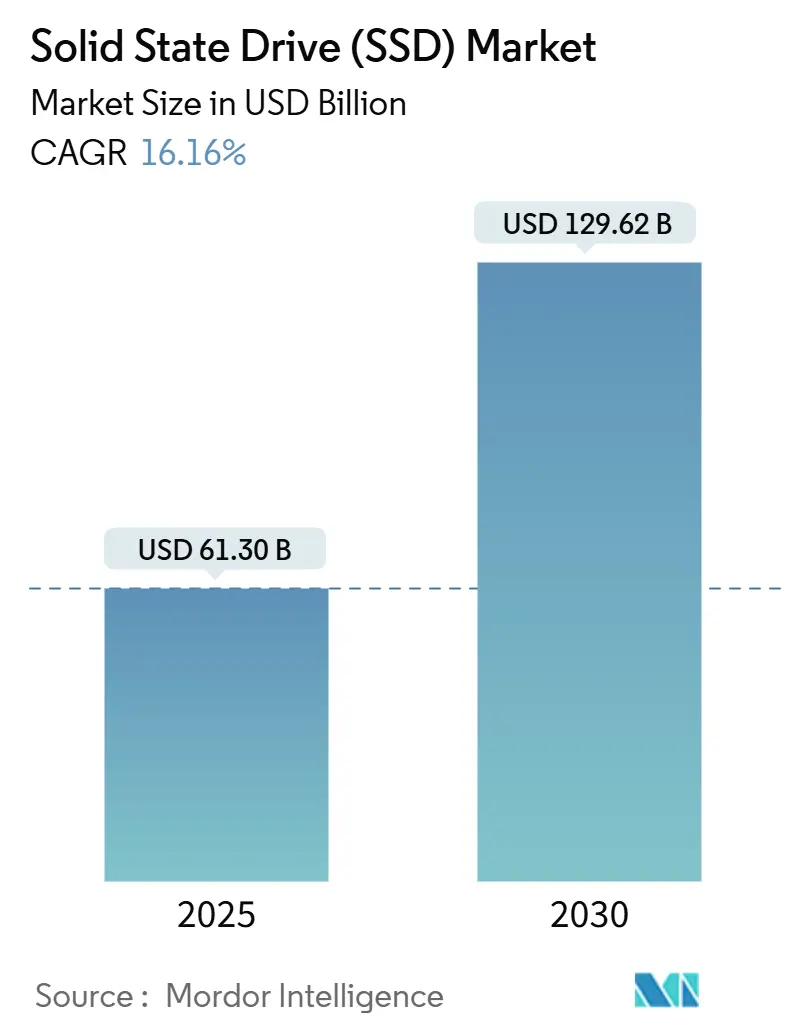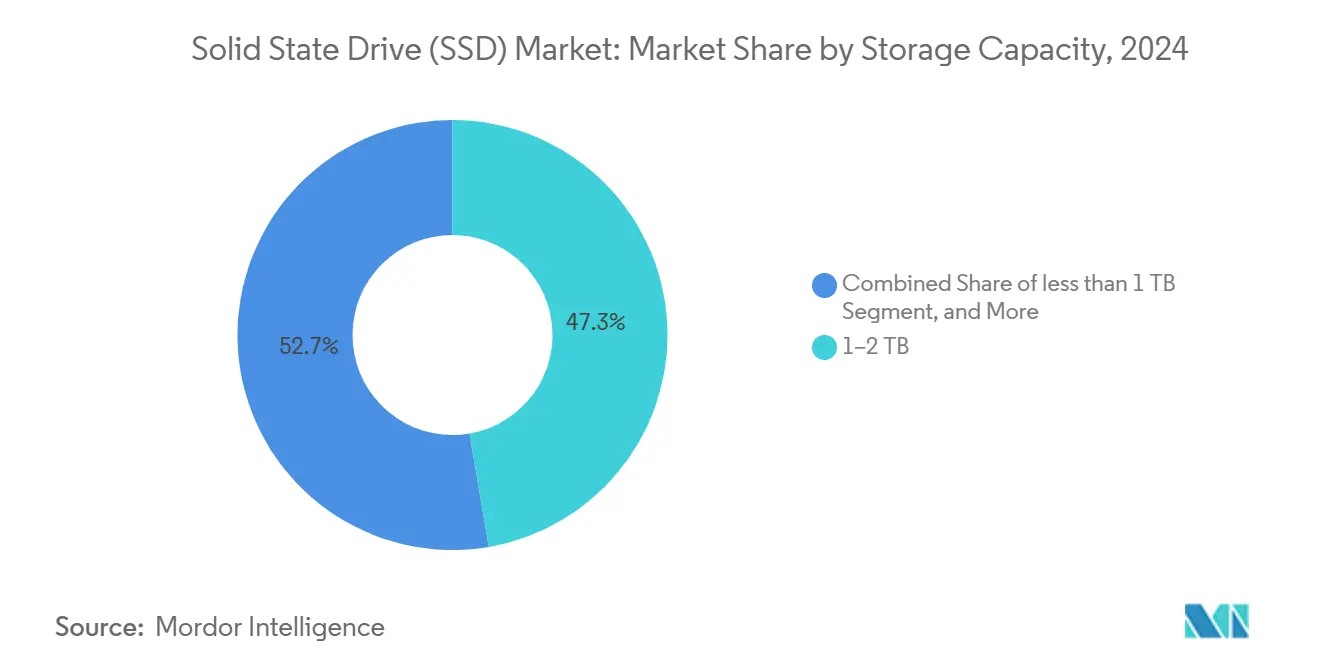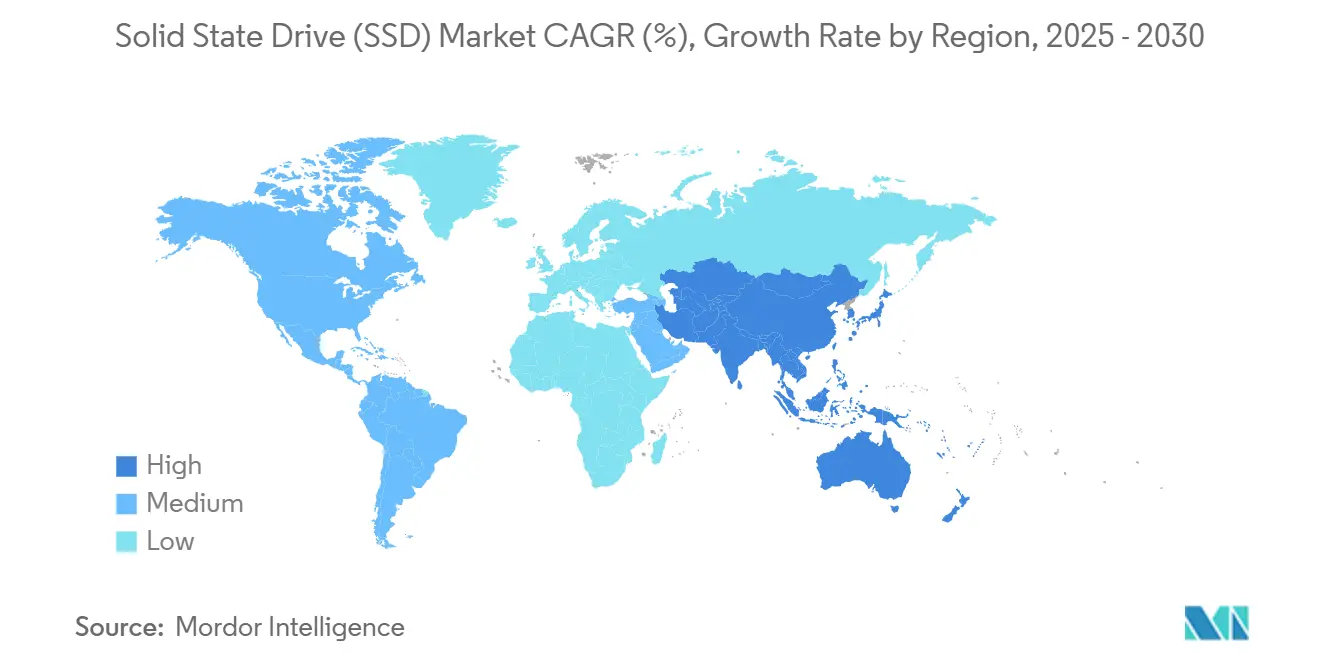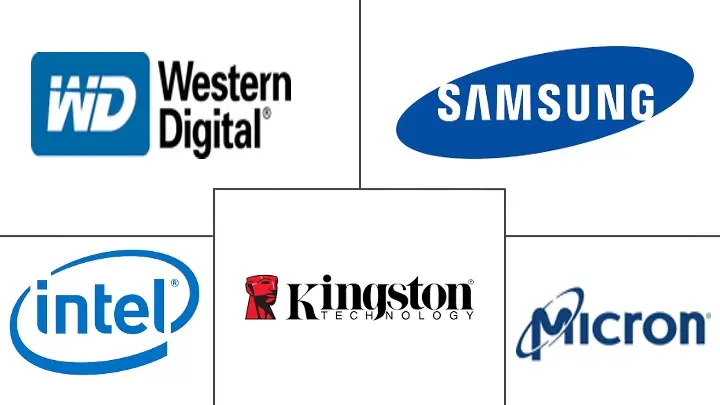Solid State Drive (SSD) Market Size and Share

Solid State Drive (SSD) Market Analysis by Mordor Intelligence
The SSD market commands USD 61.30 billion in 2025 and is on course to touch USD 129.62 billion by 2030, advancing at a 16.16% CAGR. Sharply rising demand for enterprise AI training clusters, record hyperscaler capital outlays, and an ongoing migration from mechanical media toward high-performance solid-state arrays underpin this momentum. Vendors that combine high-layer NAND, advanced PCIe interfaces, and sophisticated thermal designs are positioned to benefit as data-center architects prioritise density, efficiency, and low latency. Pricing remains fluid because NAND producers now calibrate wafer starts and layer transitions to preserve margins, yet healthy demand signals enable them to pass through selective increases. Competitive intensity also rises; Chinese suppliers gain domestic share, prompting incumbents to accelerate high-capacity QLC offerings and service-oriented firmware updates.
Key Report Takeaways
- By form factor, M.2 led with 42.70% of SSD market share in 2024, while EDSFF/E1.S is projected to expand at a 16.9% CAGR through 2030.
- By application, enterprise deployments accounted for 45.1% share of the SSD market size in 2024; AI-optimised enterprise workloads are forecast to advance at a 17.5% CAGR to 2030.
- By storage capacity, the 1–2 TB class held 47.3% of the SSD market size in 2024; capacities above 4 TB are set to climb at a 17.2% CAGR between 2025-2030.
- By end-user industry, financial services retained 22.4% share in 2024, whereas cloud service providers are projected to record an 18.9% CAGR through 2030.
- Geographically, North America commanded 26.7% revenue in 2024; Asia-Pacific is forecast to be the fastest-growing region at an 18.2% CAGR through 2030.
Global Solid State Drive (SSD) Market Trends and Insights
Drivers Impact Analysis
| Driver | (~) % Impact on CAGR Forecast | Geographic Relevance | Impact Timeline |
|---|---|---|---|
| Rapid NVMe and PCIe Gen4-5 penetration in data centers | +3.2% | Global, concentrated in North America and EU | Medium term (2-4 years) |
| Cloud-hyperscaler build-outs boosting SSD demand | +4.1% | Global, led by North America, expanding to Asia-Pacific | Short term (≤ 2 years) |
| OEM Integration in Smartphones and Tablets | +2.8% | Asia-Pacific core, spill-over to global markets | Medium term (2-4 years) |
| NAND USD/GB decline widening addressable base | +2.5% | Global | Long term (≥ 4 years) |
| AI/ML training servers' need for high-endurance QLC and TLC | +3.7% | North America and EU, expanding to Asia-Pacific | Short term (≤ 2 years) |
| Edge-computing shift to hot-swappable E1.S / EDSFF | +1.9% | Global, early adoption in hyperscale environments | Long term (≥ 4 years) |
| Source: Mordor Intelligence | |||
Rapid NVMe and PCIe Gen4-5 Penetration in Data Centers
Enterprise architects move decisively toward NVMe because PCIe Gen4 and Gen5 lanes supply the bandwidth that AI accelerators and real-time analytics now require. Hyperscalers adopt EDSFF E1.S enclosures that fit up to 64 drives per 1U, lifting density tenfold versus legacy U.2 arrays while maintaining hot-swap serviceability.[1]KIOXIA Corporation, “KIOXIA Launches EDSFF E1.S SSDs for Cloud,” kioxia.com Meta, Microsoft, and other cloud operators standardise on the newer form factor to simplify fleet service and cooling. Yet thermal loads escalate; tests on consumer Gen5 drives such as Corsair’s MP700 show shutdown within three minutes when cooling is inadequate, highlighting the importance of server chassis airflow. Firmware-based throttling for PCIe 6.0 is already in prototype, confirming that interface speed gains will only translate to application performance when heat budgets are proactively managed.
Cloud-Hyperscaler Build-outs Boosting SSD Demand
These cloud hyperscale projects translate directly into petabyte-scale SSD tenders because AI services require all-flash tiers to keep GPUs saturated. Transactional proof points emerge in enterprise settings as well: a Southeast Asian bank cut database latency by 60% by shifting to an all-NVMe fabric, while still meeting stringent RAID tolerance.[2]Huawei Technologies Co., Ltd. "TMBThanachart Bank Optimizes Data Infrastructure with an All-Flash Data Center Solution," huawei.comSuch case studies reinforce a preference for flash-only architectures, especially where consolidation lowers rack count and eases power scheduling.
AI/ML Training Servers’ Need for High-Endurance QLC and TLC
Model training reshapes qualification criteria. Capacity density and write endurance now outweigh peak IOPS, so vendors race to sample 60 TB-plus drives built on QLC. Micron’s 6550 ION achieves 12 GB/s reads at just 20 watts, delivering 67% more capacity per rack than the previous generation.[3]Micron Technology, Inc. "Micron Introduces World’s Fastest, Most Energy Efficient 60TB SSD," micron.comInternal benchmarking shows PCIe 5.0 NVMe SSDs trimming ML training runtimes by the equivalent of 32-44 days a year when multiple GPUs hit a shared data set concurrently. NVIDIA architects are said to request SSDs capable of 100 million IOPS, signalling that storage will increasingly gate GPU utilisation if specifications stall.
Restraints Impact Analysis
| Restraint | (~) % Impact on CAGR Forecast | Geographic Relevance | Impact Timeline |
|---|---|---|---|
| SSD price premium over HDD in cold-storage tiers | -1.8% | Global | Medium term (2-4 years) |
| NAND supply-chain and price volatility | -2.3% | Global, concentrated in Asia-Pacific manufacturing | Short term (≤ 2 years) |
| Limited write-endurance versus HDD for archival use | -1.2% | Global | Long term (≥ 4 years) |
| Thermal throttling and power-draw challenges in PCIe Gen5 | -1.5% | Global, acute in high-performance deployments | Medium term (2-4 years) |
| Source: Mordor Intelligence | |||
NAND Supply-Chain and Price Volatility
Producers curtailed wafer starts throughout 2024 to arrest a prolonged price slide, then deliberately raised contract pricing by 15-20% in Q3 2024 to realign profitability. The cycle injects budgeting uncertainty for buyers that depend on predictable cost curves. Industry consolidation exacerbates swings: SK Hynix closed its USD 1.9 billion acquisition of Intel’s NAND assets, concentrating output under fewer decision makers. China’s YMTC simultaneously accelerates 232-layer QLC, pushing bit density to 19.8 Gb/mm² even under export controls. Sudden alignment or misalignment between supply and hyperscale demand can therefore widen quarterly price bands and complicate long-range TCO planning.
Thermal Throttling and Power-Draw Challenges in PCIe Gen5
High-end Gen5 drives now draw 10 W or more, a threshold that forces server designers to add active cooling or throttle performance. Benchmarks on Crucial’s T700 recorded drops from 12 GB/s to 0.1 GB/s once controller temperatures touched 86 °C. Such behaviour undermines headline specifications unless thermal budgets are engineered from rack to component level. Controller vendors issue firmware patches that soften throttle curves, yet operators still face higher fan speeds and acoustic footprints. The concern will deepen as PCIe 6.0 doubles lane speeds, motivating a pivot toward materials science, power-efficient controllers, and system-level airflow analytics.
Segment Analysis
By Form Factor: EDSFF Emergence Reshapes Enterprise Storage
M.2 preserved 42.70% of SSD market share in 2024 because its slim profile aligns with client devices and entry-level servers. EDSFF E1.S, however, is on track for a 16.9% CAGR through 2030 as cloud providers favor tool-less hot-swap sleds that fit denser racks while managing thermals. U.2 lingers where dual-port PCIe is mandatory, chiefly in financial trading hubs that prize HA topologies. E3.S variants enter pilot at hyperscalers that want PCIe 5.0 performance with EDSFF serviceability. Consumer boards continue to rely on M.2 because its absence of a caddy keeps BOM costs down, yet laptop OEMs already test CAMM and soldered BGA flash as QLC cost curves sink. Over the forecast period, enterprises will progressively widen procurement policies to include E1.S and, eventually, E3.S for Gen6 deployments.

Note: Segment shares of all individual segments available upon report purchase
By Application: AI-Optimised Enterprise Accelerates Beyond Traditional Deployments
Enterprise workloads held 45.1% of the SSD market size in 2024, yet AI-tuned deployments are slated to out-run broader enterprise storage, advancing at 17.5% annually. Financial analytics, risk modelling, and generative AI inference push storage architects to co-locate flash with accelerators, so rack plans now require fewer, larger drives to reduce cross-bar latency. The SSD market share for AI-optimised storage is set to exceed 30% by 2030 as GPUs proliferate across verticals.
Client devices still ship the largest unit volumes, but commoditisation suppresses margin. Smartphones adopt UFS 4.0 NAND that posts 4,200 MB/s reads, and thin-and-light laptops jump to 4TB modules as creators demand 8K project caches. Industrial controls and autonomous robots make up a small but growing niche; these applications run in −40 °C to 85 °C envelopes and expect 150k P/E cycles, so vendors like ATP Electronics leverage pSLC modes and ECC algorithms to satisfy extended duty requirements.
By Storage Capacity: High-Capacity Drives Address AI Data Requirements
The 1–2 TB tranche held 47.3% revenue in 2024 because it balances cost per GB with capacity needs in mainstream laptops and general-purpose servers. Still, SKUs beyond 4 TB will show a 17.2% CAGR through 2030 as AI repositories and data-lake consolidation reduce array counts. Hyperscalers already pilot 60 TB E3.S modules that yield 2.5 PB in a 2U tray, shrinking floor space and power cabling complexity.
Sub-1 TB capacities will remain in embedded modules such as automotive telematics units where cost per unit dominates. Consumer gaming rigs edge toward 4 TB to support texture-rich engines and DirectStorage APIs. At the ultra-high end, R&D labs test 122.88 TB prototypes that target “warm” AI training datasets; when commercialised, these drives could cut cluster drive counts by a factor of four and slash idle power via fewer on-board processors.

Note: Segment shares of all individual segments available upon report purchase
By End-User Industry: Financial Services Lead While Cloud Providers Accelerate
Financial institutions owned 22.4% revenue share in 2024 as high-frequency traders and clearing houses require deterministic latency. They also adopt consumption-based storage plans that shift capex to opex, evidenced by DZ BANK’s use of evergreen leasing that refreshes SSD shelves without forklift upgrades. The SSD market size attributed to this vertical is projected to expand at 11% annually as real-time compliance analytics widen SSD footprints in regional banks.
Cloud service providers will experience the fastest pace at 18.9% CAGR because every layer of the IaaS-stack relies on flash when delivering AI inference at scale. Hyperscalers also quantify power per inference and increasingly publish PUE targets; all-flash displaces HDDs when watt-per-IOPS surpasses tipping points. Gaming publishers trail but remain steady as next-gen consoles ship with higher capacities and PC gamers upgrade to match UHD texture libraries. Government and defence budgets fund secure, self-encrypting SSDs with hardware root-of-trust and zeroisation capabilities; such certifications help niche suppliers differentiate against commodity flash.
Geography Analysis
North America controlled 26.7% of 2024 revenue, a position built on dense hyperscaler campuses and early AI adoption in financial and healthcare domains. The SSD market size for North America is forecast to grow to USD 31.4 billion by 2030, but its mid-teens CAGR lags Asia-Pacific because the installed base is already large. Investment tax incentives and an abundant colocation ecosystem sustain new module rollouts and keep channel inventory balanced. Enterprises in the region emphasise data-sovereignty; as a result, operators deploy zonal storage clusters across multiple metropolitan campuses to tighten data-residency compliance.
Asia-Pacific exhibits the fastest CAGR at 18.2% thanks to Chinese, South Korean, and Japanese fabs that secure local supply even when export controls tighten. Four of the ten largest SSD brands are now Chinese, and together they captured 23% global unit share during Singles’ Day 2024 promotions. Domestic hyperscalers such as Alibaba Cloud and Tencent Cloud integrate those drives into white-box servers, accelerating volume ramp. Government programmes offering tax holidays for semiconductor investments further stimulate bit output, and regional colocation players in India and Indonesia open new zones that pair domestic compute with low-latency storage.
Europe concentrates on carbon budgeting and circular-economy targets, so operators favour SSD lines with endurance analytics, power-loss protection, and verified recycling paths. Market growth remains healthy but modest because energy caps and site permitting slow hyperscale green-field builds. Instead, brown-field retrofits that replace HDDs with flash in existing shells form the bulk of shipments. Middle East data-center projects in Saudi Arabia and UAE add incremental upside, whereas Africa stays early in the adoption curve, with edge caching for telco applications as the first use case.

Competitive Landscape
Samsung retains leadership through vertical NAND integration and an aggressive node cadence, despite facing ASP pressure. SK Hynix vaults to second place after acquiring Intel’s NAND unit and folding it into Solidigm, giving it both capacity and enterprise firmware IP. Western Digital and KIOXIA collaborate on wafer-fab joint ventures, balancing risk while advancing BiCS FLASH layers. Chinese entrants, notably YMTC and its Zhitai brand, leverage domestic demand and state finance to undercut incumbent pricing, resulting in 2024 e-commerce rankings where a local brand topped Samsung for the first time.
Strategy now centres on AI-oriented offerings rather than raw sequential speed. Solidigm integrates cache-aware software that lowers write-amplification to 1.02× when feeding GPT workloads. KIOXIA partners with Kyocera on optical connectors that dissipate heat outside the package, an approach targeting PCIe 6.0. SK Hynix introduces enterprise SSDs featuring periodical self-test routines aligned with AI model checkpoints, letting operators predict replacement windows before an inference cluster degrades.
Smaller vendors carve niches in industrial and automotive where extended temperature and functional-safety ratings command premiums. ATP Electronics ships pSLC-mode drives rated for 125 °C, useful in under-hood domain controllers. Phison positions its reference designs toward VARs that bundle firmware source code, empowering integrators to build domain-specific fail-in-place features. Overall, competition heightens but remains moderately concentrated; the top five brands collectively hold slightly above 70% of 2024 revenue, leaving meaningful room for specialists that focus on ruggedised, secure, or ultra-dense workloads.
Solid State Drive (SSD) Industry Leaders
-
Intel Corporation
-
Samsung Group
-
Western Digital Corporation
-
Kingston Technology Corporation
-
Micron Technology Inc.
- *Disclaimer: Major Players sorted in no particular order

Recent Industry Developments
- March 2025: SK Hynix closed Intel’s NAND technology purchase for USD 1.9 billion, finalising integration of the acquired IP into its enterprise roadmap.
- March 2025: KIOXIA introduced the LC9 Series 122.88 TB NVMe SSD built on 8th-gen BiCS FLASH and PCIe 5.0 to serve AI training clusters.
- February 2025: PNY launched aiDAPTIV+ SSDs that couple firmware and software hooks for scalable LLM training on-prem without data-sharing risks.
- January 2025: Lenovo agreed to acquire Infinidat, broadening its high-end storage line and opening cross-sell options into hyperscale contracts.
- January 2025: Pure Storage and Micron expanded collaboration around Micron G9 QLC NAND to slash hyperscale power envelopes.
Research Methodology Framework and Report Scope
Market Definitions and Key Coverage
Our study defines the solid-state drive market as sales revenue from newly manufactured, NAND-flash based SSDs that slot inside or attach to computing, consumer, industrial, and enterprise equipment at the factory gate. Drives covered span 2.5-inch, M.2, U.2, EDSFF, and similar formats, across SATA, SAS, and PCIe/NVMe interfaces.
Scope exclusion: External USB flash sticks, hybrid HDDs, and refurbished or gray-market SSDs fall outside the boundary.
Segmentation Overview
- By Form Factor
- 2.5-inch
- M.2
- U.2
- Others
- By Application
- Enterprise / Data-Center
- Client / Consumer Devices
- Industrial and Automotive
- Others (Edge, Surveillance, IoT)
- By Storage Capacity
- Less than 1 TB
- 1 - 2 TB
- Others
- By End-user Industry
- Cloud Service Providers
- Gaming and Esports
- Financial Services
- Government and Defense
- Others
- By Geography
- North America
- United States
- Canada
- Mexico
- South America
- Brazil
- Argentina
- Colombia
- Europe
- Germany
- United Kingdom
- France
- Italy
- Spain
- Rest of Europe
- Asia-Pacific
- China
- Japan
- South Korea
- India
- Taiwan
- Rest of Asia-Pacific
- Middle East and Africa
- Middle East
- Saudi Arabia
- United Arab Emirates
- Turkey
- Rest of Middle East
- Africa
- South Africa
- Nigeria
- Egypt
- Rest of Africa
- Middle East
- North America
Detailed Research Methodology and Data Validation
Primary Research
Mordor analysts interviewed flash-controller makers, enterprise storage architects, and large e-tail distributors across North America, Asia Pacific, and Europe. The conversations gave us fresh color on near-term price erosion, channel inventory, and NVMe adoption speeds, letting us tighten assumptions drawn from desk work.
Desk Research
We began by mapping global production flows through publicly available shipment tallies from bodies such as the Semiconductor Industry Association, U.S. International Trade Commission import codes, JEDEC unit statistics, and customs dashboards from Korea and China. Company 10-Ks, quarterly filings, and investor decks supplied brand-level ASP signals, which our team then averaged by interface class. News and patent alerts inside Dow Jones Factiva and Questel helped us track emerging E1. S and E3. S designs that influence forecast mix.
Next, we layered on regional consumption indicators, PC and server shipments from IDC, cloud capacity buildouts logged by the Open Compute Project, and government electronics trade surveys in the EU and Japan to sense check demand pools. These threads feed the model's base year calibration.
The list here is illustrative; many other open and subscription sources assisted data validation and context building.
Market-Sizing & Forecasting
A top-down reconstruction starts with 2024 global NAND petabytes shipped, applies SSD share, average capacity, and blended ASP to land on 2025 revenue. Select bottom-up checks, supplier roll-ups and sampled e-commerce price × volume screens, confirm the envelope. Key variables monitored include quarterly NAND cost per gigabyte, PC and server unit forecasts, hyperscale capex, enterprise PCIe penetration, and average capacity per drive; each drives either price or volume curves. Multivariate regression on these drivers underpins the 2025-2030 projection, while scenario analysis cushions demand shocks from cyclical memory pricing. When bottom-up samples deviate beyond five percent, we adjust the base with documented rationale.
Data Validation & Update Cycle
Our multi-step review compares model outputs against independent shipment, revenue, and capacity series; outliers trigger analyst re-checks before sign-off. Reports refresh each year, with mid-cycle updates issued when large fabs, trade policies, or component shortages materially shift outlooks.
Why Mordor's Solid State Drive Baseline Earns Trust
Published estimates often diverge because firms pick different drive interfaces, price bases, and refresh cadences.
Major gap drivers include whether client-grade modules are blended with enterprise SKUs, the handling of rapid ASP compression, and the forecast start year. Mordor's model locks scope first, uses mixed variables that mirror real buying behavior, and refreshes annually, which competitors sometimes skip.
Benchmark comparison
| Market Size | Anonymized source | Primary gap driver |
|---|---|---|
| USD 61.30 B (2025) | Mordor Intelligence | - |
| USD 35.55 B (2025) | Global Consultancy A | Excludes datacenter NVMe lines; applies 2023 ASPs without 2024 price drops |
| USD 71.34 B (2025) | Industry Association B | Blends refurbished drives and uses unit-based uplift without capacity weighting |
These comparisons show that our disciplined scope setting, variable choice, and yearly refresh create a balanced, transparent baseline decision-makers can rely on.
Key Questions Answered in the Report
What is the current SSD market size and how fast is it growing?
The SSD market size stands at USD 61.30 billion in 2025 and is forecast to register a 16.16% CAGR, reaching USD 129.62 billion by 2030.
Which form factor will expand the fastest over the next few years?
EDSFF/E1.S designs are projected to grow at a 16.9% CAGR through 2030 as hyperscalers migrate from legacy U.2 and M.2 trays to denser, hot-swappable sleds.
How is AI adoption changing enterprise SSD requirements?
AI training clusters demand high-capacity QLC or TLC SSDs with elevated write endurance, leading suppliers to release drives exceeding 60 TB and controllers optimised for massive parallel reads.
Why do NAND prices remain volatile even as technology advances?
Producers cut output during downturns and then raise prices to safeguard margins; consolidation and export-control dynamics concentrate supply decisions among fewer fabs, amplifying price swings.
Which region will contribute most to incremental SSD growth?
Asia-Pacific will add the most incremental revenue, expanding at an 18.2% CAGR to 2030 thanks to local manufacturing scale and aggressive hyperscaler rollouts.
Are thermal challenges a serious obstacle to PCIe Gen5 SSD deployment?
Yes. Drives can throttle sharply without adequate cooling, so data-center operators must pair Gen5 deployments with improved chassis airflow and controller firmware tuned for temperature management.
Page last updated on:



